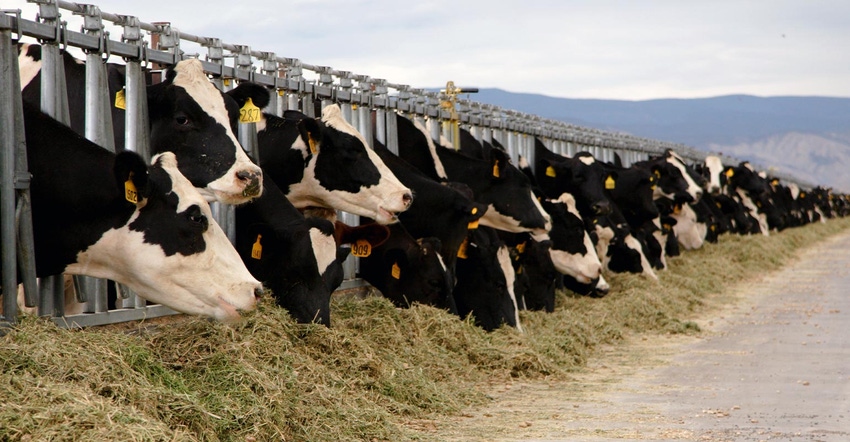Break the pathogen cycle with a whole-farm approach.
Improving herd productivity is dependent on mitigating pathogens in every corner of your operation.

Sponsored Content
Harmful pathogens lurk everywhere on a dairy, leading to a cycle of infection and reinfection that hampers herd health and performance. Taking a whole-farm approach to pathogen reduction can help you break this cycle and maintain your herd’s productivity.
Controlling pathogens on your dairy starts by understanding the pathogen cycle. Pathogenic organisms proliferate inside animals’ digestive systems and enter the environment through manure. These organisms often thrive in the manure pit or lagoon, with the potential to contaminate growing plants when manure is spread on fields. When animals eventually consume the crop in the form of grazed or harvested forage, the pathogens return to their digestive systems and the cycle begins anew, with damaging effects on health and productivity.
That’s why it’s important to consider your entire operation and address pathogens present in calves, cows, manure and forages.
Pathogen prevalence.
Three of the most prevalent pathogens on dairy farms are Clostridia, Salmonella and pathogenic E. coli. Assessing the existing pathogens on your dairy can help identify a solution for each area of your operation.
Since 2015 researchers at Arm & Hammer Animal and Food Production have analyzed clostridial risk on U.S. dairy operations. Among their findings1:
Over half of the 20,510 fecal samples tested from 509 dairies in 30 states fell into a high-risk category based on levels of clostridial bacteria
More than 70 percent of 1,200 calf fecal samples tested positive for pathogenic C. perfringens, with the highest prevalence in calves under three weeks old
Forage samples from 457 herds revealed Clostridia presence in 83 percent of haylage and 57 percent of corn silage
Pathogen vulnerabilities.
Young calves are particularly vulnerable to environmental pathogens. Exposure to pathogens during the first hours and days of life can lead to clinical scours followed by pneumonia. These illnesses compromise immunity and take energy away from growth needs, leaving calves more susceptible to other illnesses. Plus, infected calves shed pathogens into the manure to heighten risk of reinfection.
Clostridia are a common bacterial problem for young calves. Incidence of clostridial scours often traces back to a milk delivery problem when calves are fed milk at higher levels than they can handle. This allows milk to backflow into the rumen and creates a lower pH suitable for Clostridium perfringens growth.
In the lactating herd, C. perfringens Type A is often implicated in hemorrhagic bowel syndrome (HBS). Subclinical levels can cause cows to go off feed and reduce their milk production, even without signs of clinical disease.
Left uncontrolled, the pathogen cycle continues through cows' manure, which often contains clostridial bacteria, including both toxigenic and non-toxigenic C. perfringens strains.
Break the pathogen cycle.
To limit animals' exposure to pathogens, your goal should be to decrease the overall pathogen load on your dairy by breaking the pathogen cycle.
One solution is feeding CERTILLUS™ to target specific pathogenic challenges, bind them and remove them from the animal. The Targeted Microbial Solutions™ in CERTILLUS use proprietary strains of Bacillus to help make calves and cows more resilient against C. perfringens while reducing pathogen shedding into the manure. ARM & HAMMER™ researchers select the best Bacillus strains to combat the specific challenges in your herd by analyzing your Microbial Terroir™ --which includes the environment, soil and animals at your specific location.
Consider these additional practices as a part of your whole-farm pathogen control approach:
Provide high-quality colostrum to calves within the first hours of life.
Practice good hygiene across all areas of the operation. Provide clean, dry and well-ventilated housing and scrape pens and alleys frequently.
Inject manure into the soil to reduce risk of Clostridia contaminating crops. CERTILLUS manure additives can enhance breakdown in the storage system to prevent separation of manure solids that makes injection more difficult.
Follow proper silage harvesting, packing and storage procedures to achieve pH levels needed to stop plant respiration, inhibit spoilage bacteria, and inhibit Clostridia that are sensitive to low pH.
Consider CERTILLUS silage inoculants to help improve fermentation efficiency and aerobic stability in the storage structure. Beneficial Bacillus subtilis bacteria strains in CERTILLUS can reduce both toxigenic and non-toxigenic Clostridia in forages.
Conclusion.
Although it is not possible nor desirable to create a totally pathogen-free environment, proper management in all areas of the operation can help you reduce risk of transmitting disease-causing organisms. Read more about the benefits of feeding CERTILLUS to dairy animals.
1. Data collected and analyzed by ARM & HAMMER.
©2020 Church & Dwight Co., Inc. ARM & HAMMER, CERTILLUS, Microbial Terroir and Targeted Microbial Solutions are trademarks of Church & Dwight Co., Inc.
About the Author(s)
You May Also Like



